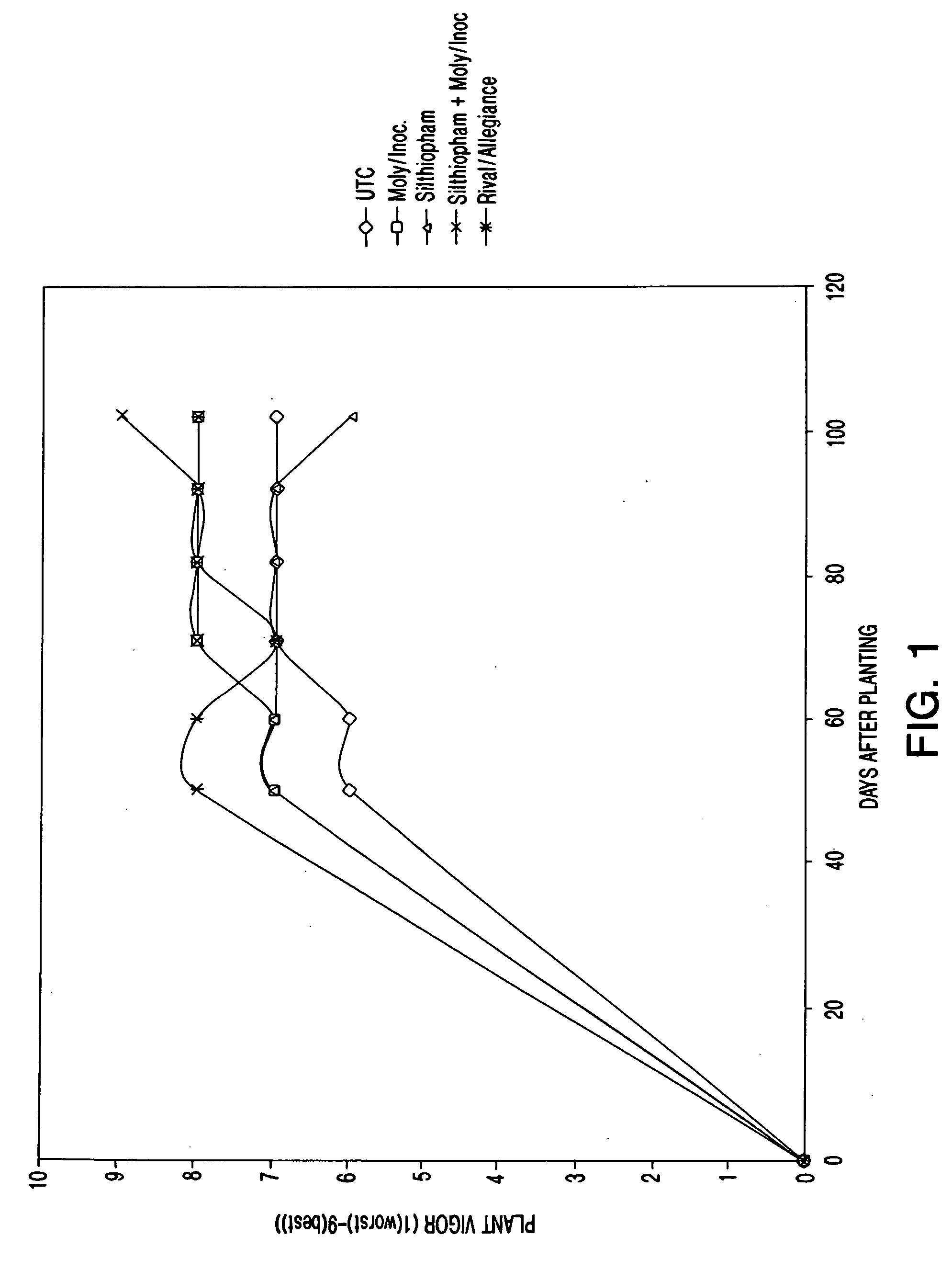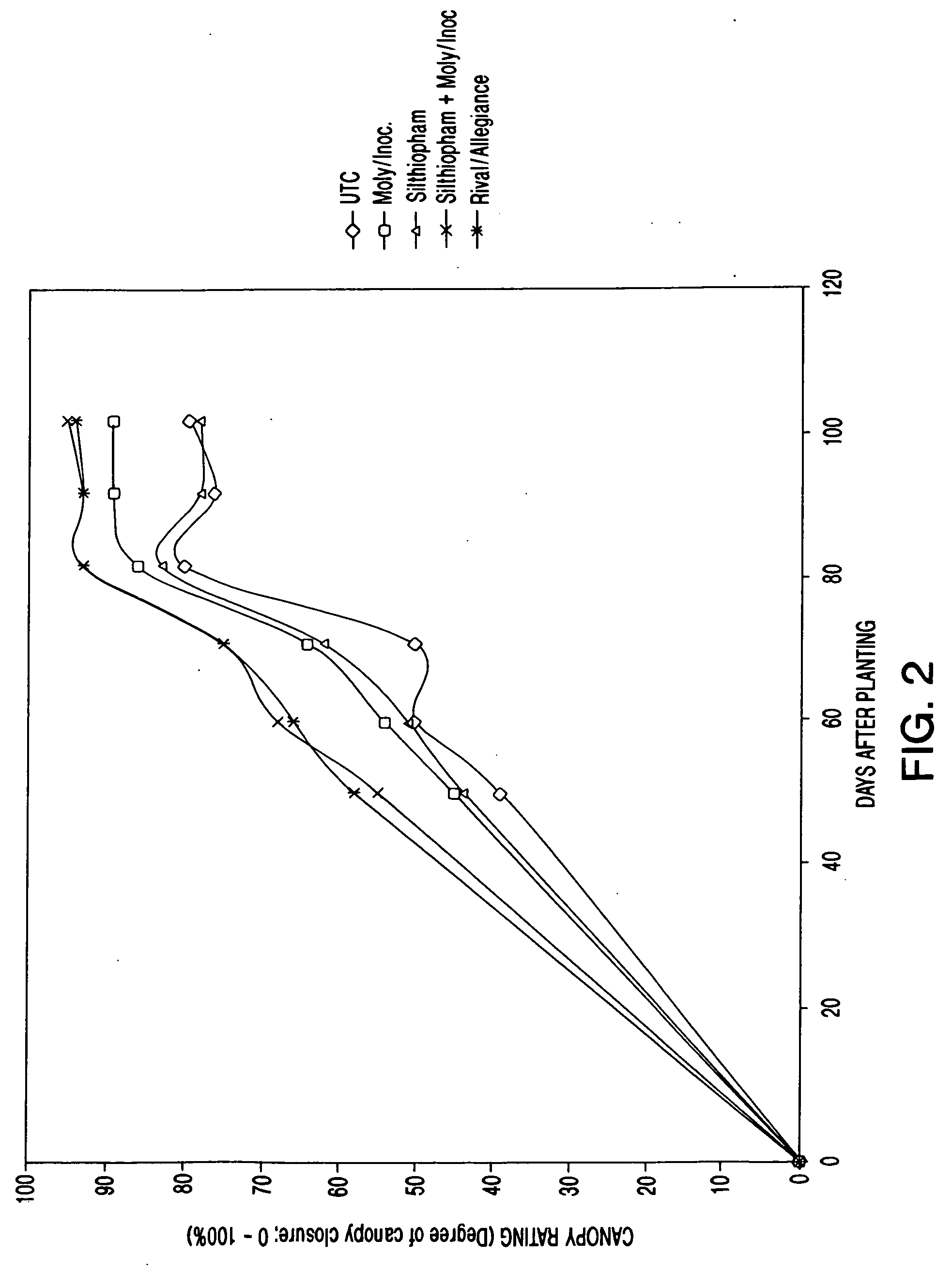Method of improving yield and vigor of plants
a technology of agronomic plants and fungicides, applied in the field of improving the yield and vigor of agronomic plants, can solve the problems of low cost of foliar fungicide treatment, adverse effects on soybean yield, and inability to apply, so as to improve the vigor and yield of agronomic plants, the effect of easy application
- Summary
- Abstract
- Description
- Claims
- Application Information
AI Technical Summary
Benefits of technology
Problems solved by technology
Method used
Image
Examples
example 1
[0390] This example shows a method of treating soybean seed with silthiofam with and without Bradyrhizobium spp. inoculum.
[0391] Soybean seed (CSR2121 variety, available from Monsanto Company, St. Louis, Mo.), was placed in a rotostatic seed treatment device (available from Hege Equipment, Inc., Colwich, Kans.). A spreader / sticker compound (Mollyflo®, available from Soygro (Pty) Ltd., Mooibank, Botchefstroom, South Africa) was added to the seed with agitation at the rate of 4 ml / kg of seed and distributed over the eed. A formulation containing 4,5-dimethyl-N-2-propenyl-2-trimethylsilyl)-3-thiophene carboxamide (silthiopham) as the active ingredient was added to the coated seed at the rate of 2 ml / kg of seed. The formulation was prepared according to the formulation shown above for Composition I, and contained about 125 gm / liter of silthiopham. The active formulation was added to the coated seed after addition of the spreader / sticker and during agitation of the seed.
[0392] For seed...
example 2
[0393] This example shows the effect of the treatment of soybean seed with silthiopham on the yield and vigor of soybean plants in a field trial in the United States.
[0394] A field trial was carried out in the upper Midwestern United States for the purpose of testing the effect of soybean seed treatment with silthiopham compared to no treatment and seed treatments with conventional materials. The soil type for the site was St. Charles silt loam having a pH of 6.4, and having P=48 ppm, K=154 ppm, and O.M.=3.0%. No fertilizer was applied, and no-tillage cultivation practice was adhered to. The trial followed Roundup-Ready® corn on which Harness® followed by Roundup® and Atrazine® had been applied according to conventional practice. There was no irrigation. The trial was of RCB 1 factor design, with 4 replications. Seeds were planted as early as possible to ensure some stress on the seeds.
[0395] Soybean seeds of the CSR2121 variety (available from Monsanto Company, St. Louis, Mo.) we...
example 3
[0401] This example shows the effect of the treatment of soybean seed with silthiofam on the yield and vigor of soybean plants in a field trial in South Africa.
[0402] Trials were conducted on five commercial soybean farms in different climatological areas in South Africa as shown in Table 3. Trial sites represent different soil types ranging from sandy to heavy clay. Trials included irrigation and dryland regions in the cool Highveld regions as well as the warmer Northern Transvaal.
TABLE 3Soybean farms, soil types, irrigation status andsoybeans cultivars used for the field trial.FARMDRYLAND orSOYBEANNUMBERIRRIGATEDCULTIVARSOIL TYPE1IrrigatedSNK500Loam2IrrigatedA5308Sandy loam3DrylandWenner90Clay loam4DrylandSNK444Sand clay 12%5DrylandSNK400Clay 40%
[0403] Soybean seed for the trial was treated in the field and planted immediately thereafter. Seed that was to receive a treatment was initially covered with Mollyflo®, or a Mollyflo®+silthiopham mixture to insure uniform coating. When...
PUM
| Property | Measurement | Unit |
|---|---|---|
| pH | aaaaa | aaaaa |
| seed weight | aaaaa | aaaaa |
| height | aaaaa | aaaaa |
Abstract
Description
Claims
Application Information
 Login to View More
Login to View More - R&D
- Intellectual Property
- Life Sciences
- Materials
- Tech Scout
- Unparalleled Data Quality
- Higher Quality Content
- 60% Fewer Hallucinations
Browse by: Latest US Patents, China's latest patents, Technical Efficacy Thesaurus, Application Domain, Technology Topic, Popular Technical Reports.
© 2025 PatSnap. All rights reserved.Legal|Privacy policy|Modern Slavery Act Transparency Statement|Sitemap|About US| Contact US: help@patsnap.com



